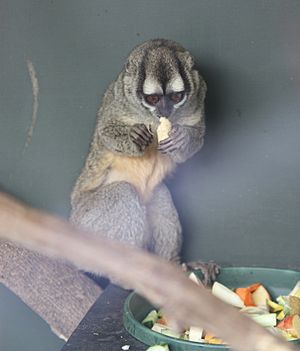Gray-handed night monkey facts for kids
Quick facts for kids Gray-handed night monkey |
|
|---|---|
 |
|
| At Marwell Wildlife, England | |
| Conservation status | |
| Scientific classification | |
| Genus: |
Aotus
|
| Species: |
griseimembra
|
 |
|
| Gray-handed Night Monkey range | |
The gray-handed night monkey (scientific name: Aotus griseimembra) is a type of night monkey. It lives in parts of Colombia and Venezuela. Scientists sometimes think it's a separate species. Other times, they consider it a subspecies of the Gray-bellied night monkey.
Contents
Where Gray-handed Night Monkeys Live
These monkeys are found in northern Colombia. Their home stretches from the Sinú River to the border with Venezuela. This includes areas like the Sierra Nevada de Santa Marta. They also live in the valleys of the Magdalena River, Cauca River, and Sao Jorge River.
In Venezuela, you can find them west and south of Maracaibo. They live in different kinds of forests. This includes forests that are growing back after being cut down. They can even be found in coffee farms! Some studies show they prefer forests with many different types of plants.
What Gray-handed Night Monkeys Look Like
The gray-handed night monkey is a fairly small monkey. Male monkeys usually weigh about 1009 grams (around 2.2 pounds). Females are a bit lighter, weighing about 923 grams (around 2 pounds).
They have short, thick fur. The fur on their back can be grayish-brown or reddish-brown. Their belly is usually yellowish. A special feature is the hair on their hands and feet. It looks like light coffee with darker tips. This helps tell them apart from other night monkeys.
How Gray-handed Night Monkeys Live
Gray-handed night monkeys are arboreal, meaning they live in trees. They are also nocturnal, which means they are active at night. They are the only monkeys that are active mostly at night! Even when the moon is full and bright, they tend to stay less active.
They live in small groups. A group usually has between two and six monkeys. Most often, it's two to four. A typical group includes an adult pair and their baby. It might also have some older young monkeys. These groups protect their territory. Their living areas usually only overlap a little bit with other groups.
Family Life and Reproduction
Like other night monkeys, the gray-handed night monkey is one of the few monogamous monkeys. This means a male and female monkey stay together as a pair. They usually have one baby each year. Sometimes, they might have twins.
A mother monkey is pregnant for about 133 days. After the baby is born, the father monkey takes care of it. He carries the baby almost all the time. He only passes it to the mother for nursing. On average, a mother has a new baby about every 271 days.
Why Gray-handed Night Monkeys Are Vulnerable
The International Union for Conservation of Nature (IUCN) lists the gray-handed night monkey as "vulnerable." This means they are at risk of becoming endangered. They are especially threatened in Colombia.
One big reason is that their habitat (their natural home) is being lost. Forests are cut down for farming or other human activities. Another reason is that many of these monkeys were captured in the 1960s and 1970s. They were used for important research on malaria.
See also
In Spanish: Mico de noche caribeño para niños


